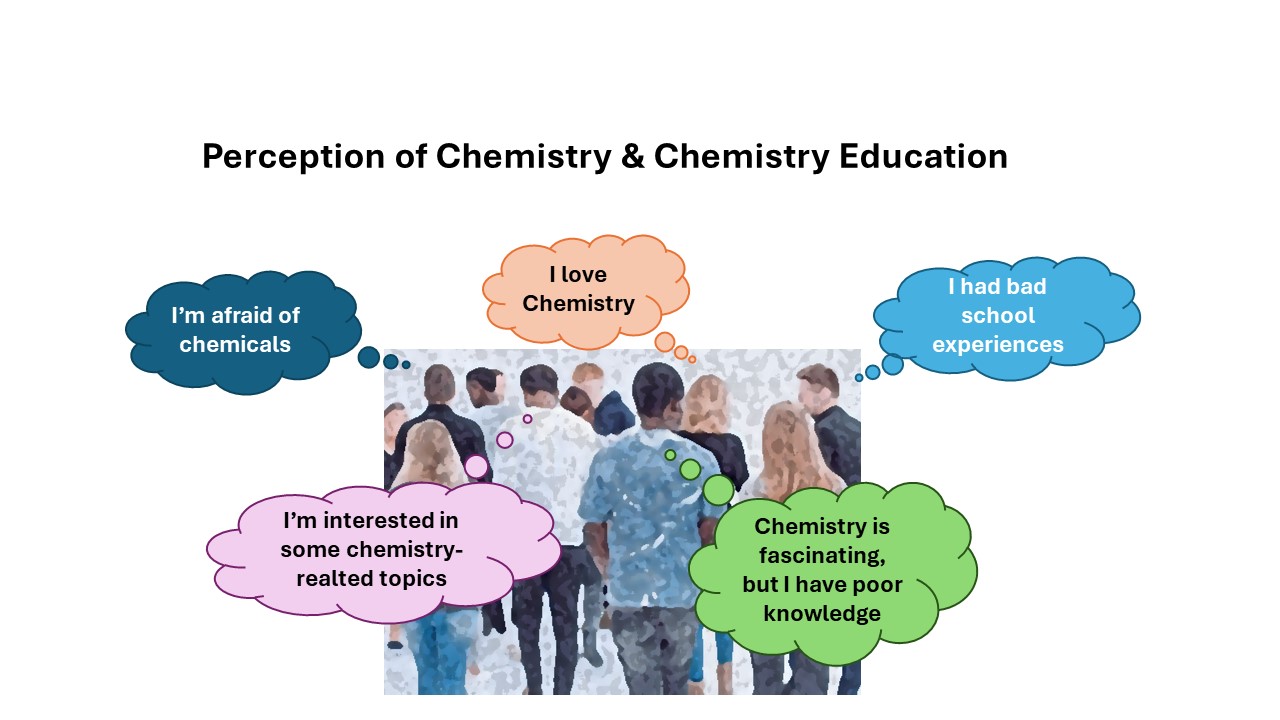
Published 2024-05-28
Keywords
- image of chemistry,
- image of science,
- perception of chemistry,
- chemistry knowledge,
- communication of chemistry
- chemistry education ...More
How to Cite
Copyright (c) 2024 Valentina Domenici, Giulia Chiocca

This work is licensed under a Creative Commons Attribution 4.0 International License.
Abstract
Perception of chemistry in the general public has been object of several investigations in the past, putting in evidence the diffusion of neutral or negative attitudes, which can be summarized in the so-called ‘chemophobic’ behaviour. In the present study we analysed the results obtained from a structured survey aimed to intercept Italian young people and to investigate the relationships among their chemistry perception, school experiences and chemistry background. The complete questionnaire was made of 29 questions (25 multiple choice questions and 4 open questions) and the analysis of results was performed on 431 participants, which were selected among initial 627 ones to exclude chemists or students in chemistry. The investigated sample gives a snapshot of Italian young people of medium-high school education, and it reveals a general not-negative perception of chemistry, but a relatively low engagement toward chemistry-related subjects. Interestingly, most people are aware of the role of chemistry teachers and school experiences in their attitude toward chemistry and, at the same time, the participants to the survey demonstrated to have a relatively poor knowledge of the main concepts of chemical science. These aspects may be helpful for chemistry educators at different levels, from primary schools to the universities.
References
- Mehlich, J.; Moser, F.; Van Tiggelen, B.; Campanella, L.; Hopf, H. The Ethical and Social Dimensions of Chemistry: Reflections, Considerations, and Clarifications. Chem. Eur. J. 2017, 23, 1210-1218.
- Domenici, V. Fake news in chemistry and how to deal with it. Science in School, published the 1st September 2023. Link: https://www.scienceinschool.org/article/2022/fake-news-how-to-deal-with-it/ (accessed on 16 February 2024).
- Habraken, C. L. Perceptions of Chemistry: why is the most common perception of Chemistry, the most visual of sciences, so distorted? J. Sci. Educ. Technol. 1996, 5, 193-201.
- Gulacar, O.; Fynewever, H. A Research Methodology for Studying What Makes Some Problems Difficult to Solve. Int. J. Sci. Educ. 2010, 32, 2167-2184. DOI: 10.1080/09500690903358335.
- Domenici, V. Superare le chemofobia. La scienza in rete. Link: https://www.scienzainrete.it/articolo/superare-chemofobia/valentina-domenici/2017-10-12 (accessed on 17 February 2024)
- Schnurr, C. "Is this natural or does it contain chemicals?" Towards a transdisciplinary understanding of the '(un-)naturalness' of chemicals. GAIA: Ecological Perspectives for Science and Society 2022, 31, 94-102. DOI: 10.14512/gaia.31.2.6
- Rollini, R.; Falciola, L.; Tortorella, S. Chemophobia: A systematic review. Tetrahedron 2022, 113, 132758.
- Jun, I.Y.; Feng, Z.; Avanasi, R.; Brain, R.A.; Prosperi, M.; Bian, J. Evaluating the perceptions of pesticide use, safety, and regulation and identifying common pesticide-related topics on Twitter. Integrated Environmental Assessment and Management 2023, 19, 1581-1599. DOI: 10.1002/ieam.4777
- Guerris, M.; Cuadros, J.; González-Sabaté, L.; Serrano, V. Describing the public perception of chemistry on twitter. Chem. Educ. Res. Pract., 2020, 21, 989-999.
- Hartings, M.R.; Fahy, D. Communicating chemistry for public engagement. Nature Chem. 2011, 3, 674-677. https://doi.org/10.1038/nchem.1094.
- Laszlo, P. On the self-image of chemists, 1950–2000. In The Public Image of Chemistry (Edited By Schummer, J.; Bensaude-Vincent, B.; Van Tiggelen, B). World Scientific Publisher, London (UK), 2017. ISBN: 978-981-277-584-9. Pages: 329–367.
- Siegrist, M.; Bearth, A. Chemophobia in Europe and reasons for biased risk perceptions. Nature Chem. 2019, 11, 1071–1072.
- Saleh, R; Bearth, A.; Siegrist, M. Addressing Chemophobia: Informational versus affect-based approaches. Food Chem Toxic. 2020, 140, Art. N. 111390.
- Francl, M. How to counteract chemophobia. Nature Chem. 2013, 5, 439-440. https://doi.org/10.1038/nchem.1661.
- Gribble, G.W.; Food Chemistry and Chemophobia. Food Security 2013, 5, 177–187. Doi: 10.1007/s12571-013-0251-2
- Chemophobia definitions from English Encyclopedia. Link: https://www.encyclo.co.uk/meaning-of-chemophobia (accessed on 19 February 2024).
- Definition of chemophobia by Wikipedia: https://en.wikipedia.org/wiki/Chemophobia (accessed on 19 February 2024).
- Berdonosov, S.S.; Kuzmenko, N.E.; Kharisov, B.I. Experience of chemical education in Russia: how to attract the young generation to chemistry under conditions of “chemophobia”. J. Chem. Educ. 1999, 76, 1086. https://doi.org/ 10.1021/ed076p1086
- Rulev, A. Chemical Education contra Chemophobia. Chimia. 2021, 75, 98-100. DOI: 10.2533/chimia.2021.98
- Webpage of the Royal Society of Chemistry: https://www.rsc.org/ (accessed on 16 February 2024).
- Webpage of the Italian Society of Chemistry (Società Chimica Italiana): https://www.soc.chim.it/ (accessed on 16 February 2024).
- Public attitudes of chemistry. Royal Society of Chemistry. Link. https://www.rsc.org/policy-evidence-campaigns/outreach/public-attitudes-chemistry/ (accessed on 16 February 2024).
- Communication tool kit. Royal Society of Chemistry. Link: https://www.rsc.org/globalassets/04-campaigning-outreach/campaigning/public-attitudes-to-chemistry/public-attitudes-to-chemistry-toolkit.pdf (accessed on 16 February 2024).
- Domenici, V. The Role of Chemistry Museums in Chemical Education for Students and the General Public. J. Chem. Educ. 2008, 85, 1365-1367.
- Domenici, V. Lifelong learning. In Insegnare e apprendere chimica, Mondadori: Firenze, Italy, 2018; pp. 159-168.
- Domenici, V. Training of Future Chemistry Teachers by a Historical / STEAM Approach Starting from the Visit to an Historical Science Museum. Substantia 2022, 7, 23–34. https://doi.org/10.36253/Substantia-1755
- Domenici, V. Project-based learning activities in the science museum as an effective training for future chemistry teachers. Educ. Sci. 2022, 12, 30; https://doi.org/10.3390/educsci12010030
- Domenici, V. I musei scientifici come luogo privilegiato per la progettazione e la realizzazione di attività didattiche educative STE(A)M. In La chimica nei musei. Creatività e conoscenza, Domenici, V.; Campanella, L. Editors; Pisa University Press: Pisa, Italy, 2020; pp. 13–26.
- Tortorella, S.; Zanelli, A.; Domenici, V. Chemistry beyond the book: open learning and activities in non-formal environments to inspire passion and curiosity, Substantia 2019, 3, 39–47. https://doi.org/10.13128/Substantia-587
- Chiocca, G.; Domenici, V. Uno studio sulla Percezione della Chimica e sulla Cultura chimico-scientifica nei giovani italiani. La chimica nella scuola (CnS), 2015, 5, 55.
- Chiocca, G. A study of the perception of Chemistry in young generations and of their chemical/scientific knowledge, Master thesis in Chemistry, University of Pisa: 2015.
- Dement, L.M.; Lucia, L.A. The Role of the Chemical Industry in Chemophobia. Bioresources. 2022, 17, 1962-1964.
- Ealy, J. Analysis of Students' Missed Organic Chemistry Quiz Questions that Stress the Importance of Prior General Chemistry Knowledge. Educ. Sci. 2018, 8, Art. N. 42. DOI: 10.3390/educsci8020042





